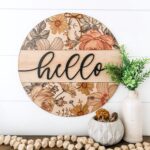I. Introduction to Embroidery for Unique Products
II. Choosing the Right Materials and Techniques for Embroidery
III. Designing and Customizing Your Unique Embroidered Products
IV. Marketing and Selling Your Unique Embroidered Products
Embroidery is an age-old craft that has recently experienced a surge in popularity, thanks to its ability to add a unique touch to everyday items. From clothing to home decor, embroidery is a versatile and creative way to personalize your belongings and make them truly one-of-a-kind.
If you’re new to the world of embroidery, fear not! It’s easier than you might think to get started. All you need are some basic materials, a bit of practice, and a whole lot of creativity. In this guide, we’ll walk you through the ins and outs of embroidery, helping you create unique products that you can be proud of.
Whether you’re looking to spruce up a plain t-shirt, add a pop of color to a throw pillow, or create a personalized gift for a friend, embroidery is the perfect way to add a personal touch to your belongings. With a few simple stitches and some colorful thread, you can transform even the most basic items into works of art.
Embroidery is a great way to express yourself and show off your creativity. Whether you’re a seasoned pro or a complete beginner, there’s something truly satisfying about watching a design come to life stitch by stitch. So why not give it a try and see where your creativity takes you?
In the following sections, we’ll cover everything you need to know to get started with embroidery, from choosing the right materials and techniques to designing and customizing your unique embroidered products. We’ll also share some tips on how to market and sell your creations, so you can share your love of embroidery with the world.
So grab your hoop, thread your needle, and get ready to embark on a creative journey unlike any other. With embroidery, the possibilities are endless, and the only limit is your imagination. So let’s dive in and discover the wonderful world of embroidery together.
Now, let’s move on to choosing the right materials and techniques for your embroidery projects.
II. Choosing the Right Materials and Techniques for Embroidery
In the world of embroidery, choosing the right materials and techniques is key to creating unique and stunning products that stand out. Whether you’re a beginner or an experienced embroiderer, understanding the different options available to you can make all the difference in the final result of your embroidery project.
When it comes to materials, the type of fabric you choose can greatly impact the outcome of your embroidery. For beginners, it’s best to start with a medium-weight fabric such as cotton or linen. These fabrics are easy to work with and provide a stable base for your embroidery stitches. As you become more experienced, you can experiment with different types of fabrics like silk or velvet to add a touch of luxury to your creations.
In addition to fabric, the type of thread you use is also important. Embroidery floss is the most common type of thread used for embroidery, and it comes in a wide range of colors and textures. When choosing thread for your project, make sure to match the weight of the thread to the weight of the fabric. Using a heavier thread on a delicate fabric can cause puckering, while using a lighter thread on a heavy fabric may not stand out as much.
When it comes to techniques, there are endless possibilities for creating unique embroidered designs. From traditional stitches like the satin stitch and French knot to more modern techniques like beading and stumpwork, the sky’s the limit when it comes to experimenting with different techniques. Don’t be afraid to try new things and push the boundaries of traditional embroidery to create truly one-of-a-kind pieces.
One important technique to keep in mind is the use of stabilizers. Stabilizers are essential for keeping your fabric taut and preventing it from puckering while you embroider. There are different types of stabilizers available, such as tear-away and water-soluble, so make sure to choose the right one for your project.
In addition to materials and techniques, it’s also important to consider the design of your embroidery project. Whether you’re creating a custom piece for yourself or for sale, the design is what will ultimately draw people in. Take the time to sketch out your design before you start embroidering, and don’t be afraid to make changes along the way if something isn’t working.
By taking the time to choose the right materials and techniques for your embroidery project, you can create unique and stunning pieces that will impress everyone who sees them. Experiment with different fabrics, threads, and techniques to create a style that is all your own. Remember, embroidery is a form of art, so don’t be afraid to let your creativity shine through in your work.
—
Choosing the Right Materials and Techniques for Embroidery
- Start with a medium-weight fabric like cotton or linen for beginners
- Match the weight of the thread to the weight of the fabric
- Experiment with different types of fabrics like silk or velvet for more experienced embroiderers
- Try different techniques like satin stitch, French knot, beading, and stumpwork
- Use stabilizers to keep your fabric taut and prevent puckering
- Sketch out your design before starting to embroider
Designing and Customizing Your Unique Embroidered Products
So, you’ve mastered the basics of embroidery and you’re ready to take your skills to the next level by designing and customizing your unique embroidered products. This is where the real fun begins! Whether you’re creating personalized gifts for friends and family or starting your own embroidery business, the possibilities are endless when it comes to designing and customizing your creations.
1. Choose Your Design:
The first step in designing your embroidered products is to choose the perfect design. You can either create your own design or use existing patterns and templates. Be sure to consider the size, placement, and color scheme of your design to ensure that it will look great on your chosen product.
2. Select Your Materials:
Once you have your design in mind, it’s time to select the materials you’ll need. From fabric and thread to needles and hoops, make sure you have everything you need to bring your design to life. Consider the texture and weight of the fabric, as well as the quality of the thread, to ensure a professional-looking finished product.
3. Embroidery Techniques:
There are several embroidery techniques you can use to customize your products, including satin stitch, chain stitch, and French knots. Experiment with different stitches and techniques to add texture and dimension to your designs. Don’t be afraid to get creative and try new things – that’s what makes your products unique!
4. Personalization:
One of the best things about embroidery is the ability to personalize your products. Whether you’re adding a monogram, a name, or a special date, adding a personal touch to your designs can make them even more special. Consider using different fonts and colors to make your personalization stand out.
5. Embellishments:
In addition to embroidery, you can also add embellishments to your products to make them truly one-of-a-kind. Consider adding beads, sequins, or ribbons to enhance your designs. Just be sure not to overdo it – sometimes less is more when it comes to embellishments.
6. Finishing Touches:
Once you’ve completed your embroidery and any additional embellishments, it’s time to add the finishing touches. Trim any excess threads, iron your design to remove any wrinkles, and carefully inspect your product for any flaws. Pay attention to the details to ensure a polished and professional-looking finished product.
Designing and customizing your unique embroidered products is a fun and rewarding process that allows you to showcase your creativity and skills. Whether you’re creating gifts for loved ones or building a business, the possibilities are endless when it comes to embroidery. So grab your materials, choose your design, and let your creativity run wild!
Embroidery is a beautiful art form that allows you to create unique and personalized products. Once you have honed your skills and created stunning embroidered pieces, the next step is to market and sell your creations. Here are some tips on how to effectively market and sell your embroidered products:
1. Establish an Online Presence
In today’s digital age, having an online presence is crucial for any business. Create a website or an online store where you can showcase your embroidered products. Use high-quality images and detailed descriptions to attract potential customers.
2. Utilize Social Media
Social media platforms like Instagram, Facebook, and Pinterest are great tools for promoting your embroidered products. Share pictures of your work, engage with your followers, and use relevant hashtags to reach a wider audience.
3. Collaborate with Influencers
Collaborating with influencers in the crafting or fashion industry can help you reach a larger audience. Send them samples of your embroidered products in exchange for a shoutout or a review on their social media channels.
4. Attend Craft Fairs and Markets
Participating in craft fairs, markets, and pop-up events is a great way to showcase your embroidered products in person. This allows potential customers to see and feel the quality of your work, which can help boost sales.
5. Offer Customization Options
Many customers love personalized products. Consider offering customization options for your embroidered products, such as adding initials, names, or special dates. This can make your products more appealing to a wider audience.
6. Collaborate with Other Small Businesses
Partnering with other small businesses that complement your products can be a win-win situation. For example, you could collaborate with a local boutique to sell your embroidered products in their store, or team up with a photographer to create unique product images.
7. Provide Excellent Customer Service
Word-of-mouth recommendations are powerful in the crafting community. Make sure to provide excellent customer service to every person who purchases your embroidered products. Respond to inquiries promptly, address any issues or concerns, and show your appreciation to your customers.
By implementing these marketing and selling strategies, you can effectively promote and sell your unique embroidered products. Remember to stay true to your brand and vision, and continue to hone your craft to create stunning and in-demand products. Good luck!
“`html
1. Establish an Online Presence
In today’s digital age, having an online presence is crucial for any business. Create a website or an online store where you can showcase your embroidered products. Use high-quality images and detailed descriptions to attract potential customers.
2. Utilize Social Media
Social media platforms like Instagram, Facebook, and Pinterest are great tools for promoting your embroidered products. Share pictures of your work, engage with your followers, and use relevant hashtags to reach a wider audience.
3. Collaborate with Influencers
Collaborating with influencers in the crafting or fashion industry can help you reach a larger audience. Send them samples of your embroidered products in exchange for a shoutout or a review on their social media channels.
4. Attend Craft Fairs and Markets
Participating in craft fairs, markets, and pop-up events is a great way to showcase your embroidered products in person. This allows potential customers to see and feel the quality of your work, which can help boost sales.
5. Offer Customization Options
Many customers love personalized products. Consider offering customization options for your embroidered products, such as adding initials, names, or special dates. This can make your products more appealing to a wider audience.
6. Collaborate with Other Small Businesses
Partnering with other small businesses that complement your products can be a win-win situation. For example, you could collaborate with a local boutique to sell your embroidered products in their store, or team up with a photographer to create unique product images.
7. Provide Excellent Customer Service
Word-of-mouth recommendations are powerful in the crafting community. Make sure to provide excellent customer service to every person who purchases your embroidered products. Respond to inquiries promptly, address any issues or concerns, and show your appreciation to your customers.
By implementing these marketing and selling strategies, you can effectively promote and sell your unique embroidered products. Remember to stay true to your brand and vision, and continue to hone your craft to create stunning and in-demand products. Good luck!
“`









Comments